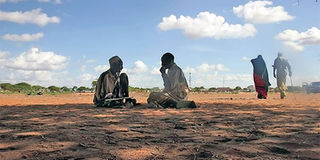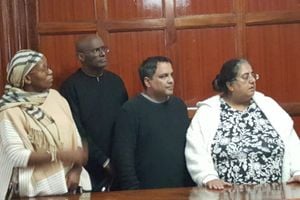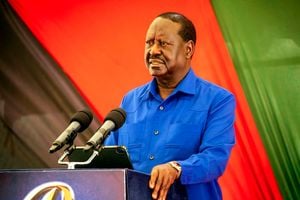Beautiful side of Wajir you don’t know

Orahey field outside Wajir Town is a hub of activity. PHOTO| COURTESY
What you need to know:
- The children told me about their hope for a bright future.
- Here I was, a stranger, a non-Muslim in this classroom with walls scribbled, tattooed and pockmarked, and none of that mattered.
- The boys spoke only the sparest of Swahili, and a smattering of English.
The airport was the first surprise. When we boarded the small aircraft at Wilson Airport for Wajir in northern Kenya, the image I had of my destination was probably hardly any different from the one constructed by many Kenyans.
The thought of northern Kenya conjured up images of terrifying hunger, emaciated cows, fractious communities and scorched land. But this was not the case when we landed at Wajir International Airport.
The first bar of the domino fell as soon as the small plane winged left and taxied onto the runway. There were several planes, the kind you would find at a major airport: commercial jets and other smaller propeller planes.
“Welcome to Wajir,” the young pilot announced. “Wajir International Airport,” he added. He must have seen hundreds of surprised faces.
The sight that greeted us was incredible. The sun shone fiercely as heat waves shimmered on the asphalt.
Wajir County would be my host for the next two days. I was part of a media crew accompanying officials of a local bank for an initiative seeking to empower marginalised communities.
As I hauled my bag into the customs desk, I wondered what other surprise waited out there.
Located about 5km East of Wajir Town, Wajir Airport has grown from a military airbase to become the third largest and busiest airports in Kenya in passenger and aircraft movement.
This has been propelled by a growing number of airline operators handling domestic and international flights.

Wajir international airport. PHOTO| COURTESY
A few minutes later, we were all set to head to our destination.
As the all-terrain vehicle picked its way inland heading to Tula Tula Village, where we would be based, the land became craggier, with the thorny acacia the only vegetation for miles.
We had driven a few kilometres into the heart of the land when Abdi, our driver, slowed down and pointed outside.
"Wagalla,” he said. “You know about the Wagalla massacre? That is where it happened.”
The massacre, an operation mounted by security forces in February 1984 allegedly to disarm the Degodia clan following inter-clan clashes, left thousands of people dead.
The massacre remains a blot on the canvas of the country’s history. As we listened to Abdi, there was almost a palpable feeling of despair and long-held pain.
He explained that Wajir Town is a host to several other sites and monuments among them the Yahut Dam, Shaletey wells, monumental buildings, the British bunkers and Orahey wells.
Tula Tula centre stood on red earth. Villagers were anxiously waiting for us. The mission was to issue them with social security cards with which they could access funds provided by the government and development partners.
People travel for work, leisure or for escapism. But in almost all cases, no traveller returns home unchanged.
Later in the day, I stole out of the camp to comb the neighbourhood and pick a few stories.
Not too far from the centre was a primary school. There was no life. But when I entered one of the classrooms, I found four boys. Shy at first and clearly wary of a stranger with a camera, they slowly warmed to our meeting.
The school was empty. They told me because the heat was so intense in the afternoon, no learning could take place. The desks were old and etched with stories, the walls covered with graffiti.
In a way, this empty class hall situated 20km from Wajir Town and near the site of the Wagalla massacre was a microcosm of Wajir; all the villages and all the people.
The stories were dipped in a pot of despair, missing pieces and decades of loss. The Wajir of the news.
But in this room, in the four pairs of eyes, away from TV cameras, that catalogue of slights was upended and now lay writhing like an upturned beetle. The boys read aloud from the Quran, in Arabic.
"You read Arabic?” I asked.
FAMED ORAHEY FIELD
The children told me about their hope for a bright future. Here I was, a stranger, a non-Muslim in this classroom with walls scribbled, tattooed and pockmarked, and none of that mattered.
The boys spoke only the sparest of Swahili, and a smattering of English. We sat there smiling goofily, saying nothing and everything; this man carrying a camera, these young boys with shining eyes.
It mattered not a bit. We were now in a play, the eternal grasp of that basic human experience; we were the cast, and we were plain: here I was, stripped of all foolishness, stripped of the city.
Outside, the local Masjid-mosque stood in the sun, its minaret piercing the afternoon as would a church steeple.
A smiling young muezzin sat outside waiting for the hour when he would walk into the hall and talk into the horn, his voice as sonorous and poetic summoning everyone to open their palms, to roll the prayer rugs and wait.
To give thanks, to listen.

Pupils inside a classroom at Tula Tula centre. PHOTO| COURTESY
With the cards issued, our mission thus complete, we drove back to Wajir Town. Along the way we passed a lorry full of jerrycans, prompting an interesting conversation.
A young man, a cashier in a local bank, told us that many of the notes deposited at the bank were usually soiled.
The reason, he said was that because of transport challenges, herders who traded in milk left containers at a designated point and returned home.
Later, the driver of a delivery truck would stop at the agreed point, burrow the money into a shallow hole and proceed with his journey.
“It’s an honour system that works efficiently well,” the banker said, adding with a laugh, “Well, the matter of the soiled notes is another thing.”
The hotel room did not have the obligatory Gideons’ New Testament Bible found in every hotel.
Instead, spread on the floor, was a small, green prayer rug. The muezzin had explained to me that prayer could be said anywhere, even by someone like me — a non-Muslim. The heart of man, he told me, that’s what mattered.
The famed Orahey field outside town was one place I wanted to see.
Orahey, which translates to ‘open field’, has long been the centre of activity in the town.
The open field, where communal water wells abound, are scattered Italian bunkers and British defensive structures.
It had rained the previous night and donkeys and goats drank from the pooled water at the edge of the field, while a pair of marabou groomed themselves.
Then I saw them; two men who appeared to be in a spirited discussion, most likely a business deal. They sat at the end of a shadow cast by an acacia tree. Occasionally they would write in the sand using a cane.
The ground told of a trade transaction almost sealed. No sentence came unclothed; every word tumbled out garbed in gestures — a fist, a finger, perfectly understood, and urgent, and correctly interpreted.
At a distance, a man and a woman walked in the sun; the pair seemed to float out of the shadows, summoning the wind behind them.




